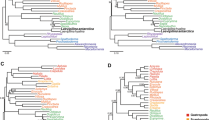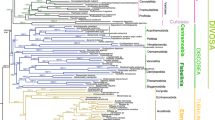Abstract
Long-held ideas regarding the evolutionary relationships among animals have recently been upended by sometimes controversial hypotheses based largely on insights from molecular data1,2. These new hypotheses include a clade of moulting animals (Ecdysozoa)3 and the close relationship of the lophophorates to molluscs and annelids (Lophotrochozoa)4. Many relationships remain disputed, including those that are required to polarize key features of character evolution, and support for deep nodes is often low. Phylogenomic approaches, which use data from many genes, have shown promise for resolving deep animal relationships, but are hindered by a lack of data from many important groups. Here we report a total of 39.9 Mb of expressed sequence tags from 29 animals belonging to 21 phyla, including 11 phyla previously lacking genomic or expressed-sequence-tag data. Analysed in combination with existing sequences, our data reinforce several previously identified clades that split deeply in the animal tree (including Protostomia, Ecdysozoa and Lophotrochozoa), unambiguously resolve multiple long-standing issues for which there was strong conflicting support in earlier studies with less data (such as velvet worms rather than tardigrades as the sister group of arthropods5), and provide molecular support for the monophyly of molluscs, a group long recognized by morphologists. In addition, we find strong support for several new hypotheses. These include a clade that unites annelids (including sipunculans and echiurans) with nemerteans, phoronids and brachiopods, molluscs as sister to that assemblage, and the placement of ctenophores as the earliest diverging extant multicellular animals. A single origin of spiral cleavage (with subsequent losses) is inferred from well-supported nodes. Many relationships between a stable subset of taxa find strong support, and a diminishing number of lineages remain recalcitrant to placement on the tree.
This is a preview of subscription content, access via your institution
Access options
Subscribe to this journal
Receive 51 print issues and online access
$199.00 per year
only $3.90 per issue
Buy this article
- Purchase on SpringerLink
- Instant access to full article PDF
Prices may be subject to local taxes which are calculated during checkout


Similar content being viewed by others
References
Giribet, G. Current advances in the phylogenetic reconstruction of metazoan evolution. A new paradigm for the Cambrian explosion? Mol. Phylogenet. Evol. 24, 345–357 (2002)
Halanych, K. M. The new view of animal phylogeny. Ann. Rev. Ecol. Evol. Sys. 35, 229–256 (2004)
Aguinaldo, A. M. A. et al. Evidence for a clade of nematodes, arthropods and other moulting animals. Nature 387, 489–493 (1997)
Halanych, K. M. et al. Evidence from 18S ribosomal DNA that the lophophorates are protostome animals. Science 267, 1641–1643 (1995)
Schmidt-Rhaesa, A. Tardigrades - Are they really miniaturized dwarfs? Zool. Anz. 240, 549–555 (2001)
Philippe, H. & Telford, M. J. Large-scale sequencing and the new animal phylogeny. Trends Ecol. Evol. 21, 614–620 (2006)
Bourlat, S. J. et al. Deuterostome phylogeny reveals monophyletic chordates and the new phylum Xenoturbellida. Nature 444, 85–88 (2006)
Delsuc, F. et al. Tunicates and not cephalochordates are the closest living relatives of vertebrates. Nature 439, 965–968 (2006)
Philippe, H., Lartillot, N. & Brinkmann, H. Multigene analyses of bilaterian animals corroborate the monophyly of Ecdysozoa, Lophotrochozoa, and Protostomia. Mol. Biol. Evol. 22, 1246–1253 (2005)
Philippe, H. et al. Phylogenomics of eukaryotes: impact of missing data on large alignments. Mol. Biol. Evol. 21, 1740–1752 (2004)
Lartillot, N. & Philippe, H. A Bayesian mixture model for across-site heterogeneities in the amino-acid replacement process. Mol. Biol. Evol. 21, 1095–1109 (2004)
Philip, G. K., Creevey, C. J. & McInerney, J. O. The Opisthokonta and the Ecdysozoa may not be clades: stronger support for the grouping of plant and animal than for animal and fungi and stronger support for the Coelomata than Ecdysozoa. Mol. Biol. Evol. 22, 1175–1184 (2005)
Rokas, A., Kruger, D. & Carroll, S. B. Animal evolution and the molecular signature of radiations compressed in time. Science 310, 1933–1938 (2005)
Baurain, D., Brinkmann, H. & Philippe, H. Lack of resolution in the animal phylogeny: closely spaced cladogenesis or undetected systematic errors? Mol. Biol. Evol. 24, 6–9 (2006)
Philippe, H. et al. Acoel flatworms are not Platyhelminthes: evidence from phylogenomics. PLoS One 2, e717 (2007)
Blair, J. E. et al. The evolutionary position of nematodes. BMC Evol. Biol. 2, 1–7 (2002)
Thorley, J. L. & Wilkinson, M. Testing the phylogenetic stability of early tetrapods. J. Theor. Biol. 200, 343–344 (1999)
Giribet, G., Distel, D. L., Polz, M., Sterrer, W. & Wheeler, W. C. Triploblastic relationships with emphasis on the acoelomates and the position of Gnathostomulida, Cycliophora, Plathelminthes, and Chaetognatha: a combined approach of 18S rDNA sequences and morphology. Syst. Biol. 49, 539–562 (2000)
Telford, M. J., Wise, M. J. & Gowri-Shankar, V. Consideration of RNA secondary structure significantly improves likelihood-based estimates of phylogeny: examples from the Bilateria. Mol. Biol. Evol. 22, 1129–1136 (2005)
Struck, T. H. et al. Annelid phylogeny and the status of Sipuncula and Echiura. BMC Evol. Biol. 7, 57 (2007)
Giribet, G. et al. Evidence for a clade composed of molluscs with serially repeated structures: monoplacophorans are related to chitons. Proc. Natl Acad. Sci. USA 103, 7723–7728 (2006)
Conway Morris, S. & Peel, J. S. Articulated Halkieriids from the Lower Cambrian of North Greenland and their role in early protostome evolution. Phil. Trans. R. Soc. Lond. B 347, 305–358 (1995)
Nielsen, C. Animal Evolution, Interrelationships of the Living Phyla 2nd edn (Oxford Univ. Press, Oxford, 2001)
Giribet, G., Edgecombe, G. D. & Wheeler, W. C. Arthropod phylogeny based on eight molecular loci and morphology. Nature 413, 157–161 (2001)
Mallatt, J. M., Garey, J. R. & Shultz, J. W. Ecdysozoan phylogeny and Bayesian inference: first use of nearly complete 28S and 18S rRNA gene sequences to classify the arthropods and their kin. Mol. Phylogenet. Evol. 31, 178–191 (2004)
Hwang, U. W. et al. Mitochondrial protein phylogeny joins myriapods with chelicerates. Nature 413, 154–157 (2001)
Freeman, G. & Martindale, M. Q. The origin of mesoderm in phoronids. Dev. Biol. 252, 301–311 (2002)
van Dongen, S. A cluster algorithm for graphs. National Research Institute for Mathematics and Computer Science in the Netherlands, Amsterdam. Technical Report INS-R0010 (Stichting Mathematisch Centrum, Amsterdam, 2000)
Enright, A. J., Van Dongen, S. & Ouzounis, C. A. An efficient algorithm for large-scale detection of protein families. Nucleic Acids Res. 30, 1575–1584 (2002)
Smith, S. A. & Dunn, C. W. Phyutility: a phyloinformatics tool for trees, alignments, and molecular data. Bioinformatics doi: 10.1093/bioinformatics/btm619 (2008)
Parkinson, J. et al. PartiGene — constructing partial genomes. Bioinformatics 20, 1398–1404 (2004)
Thompson, J. D., Higgins, D. G. & Gibson, T. J. CLUSTAL W: improving the sensitivity of progressive multiple sequence alignment through sequence weighting, position-specific gap penalties and weight matrix choice. Nucleic Acids Res. 22, 4673–4680 (1994)
Marchler-Bauer, A. et al. CDD: a Conserved Domain Database for protein classification. Nucleic Acids Res. 33 (Database issue). D192–D196 (2005)
Tatusov, R. L. et al. The COG database: an updated version includes eukaryotes. BMC Bioinformatics 4, 41 (2003)
van Dongen, S. Graph Clustering by Flow Simulation. PhD thesis, Univ. Utrecht. (2000)
Swofford, D. L. PAUP*: Phylogenetic Analysis Using Parsimony (* and Other Methods) Version 4 (Sinauer Associates, Sunderland, Massachusetts, 2003)
Edgar, R. C. & Journals, O. MUSCLE: multiple sequence alignment with high accuracy and high throughput. Nucleic Acids Res. 32, 1792–1797 (2004)
Castresana, J. Selection of conserved blocks from multiple alignments for their use in phylogenetic analysis. Mol. Biol. Evol. 17, 540–552 (2000)
Roure, B., Rodriguez-Ezpeleta, N. & Philippe, H. SCaFoS: a tool for Selection, Concatenation and Fusion of Sequences for phylogenomics. BMC Evol. Biol. 7, S2 (2007)
Huelsenbeck, J. P. & Ronquist, F. MrBayes: Bayesian inference of phylogeny. Bioinformatics 17, 754–755 (2001)
Stamatakis, A. RAxML-VI-HPC: maximum likelihood-based phylogenetic analyses with thousands of taxa and mixed models. Bioinformatics 22, 2688–2690 (2006)
Acknowledgements
We thank all participants in the Protostome Assembling the Tree of Life (AToL) Project as well as E. J. Edwards, T. Dubuc, A. Stamatakis, J. Q. Henry and S. Maslakova. A.H. received support from the Deutsche Forschungsgemeinschaft, and M.O. received support from the Swedish Taxonomy Initiative and the Royal Swedish Academy of Sciences. The Capitella sp. EST data were produced by the US Department of Energy Joint Genome Institute (http://www.jgi.doe.gov/Capitella), as were the Mnemiopsis dbEST (http://www.ncbi.nlm.nih.gov/dbEST/) data. This work was funded by two consecutive collaborative grants from the AToL program from the US National Science Foundation. Ctenophore sequencing was supported by NASA.
Author information
Authors and Affiliations
Corresponding author
Additional information
The concatenated sequence matrix has been deposited at TreeBase (http://www.treebase.org). The raw sequence data are available at the NCBI Trace Archives (http://www.ncbi.nlm.nih.gov/Traces), and can be retrieved with the query ‘center_name = 'KML-UH'’.
Supplementary information
Supplementary Information
This file contains the Supplementary Discussions, Supplementary Tables 1-4, and Supplementary Figures 1-10 with Legends and additional references. (PDF 1800 kb)
Rights and permissions
About this article
Cite this article
Dunn, C., Hejnol, A., Matus, D. et al. Broad phylogenomic sampling improves resolution of the animal tree of life. Nature 452, 745–749 (2008). https://doi.org/10.1038/nature06614
Received:
Accepted:
Published:
Issue Date:
DOI: https://doi.org/10.1038/nature06614




